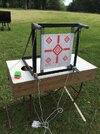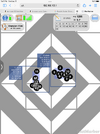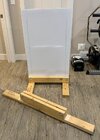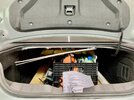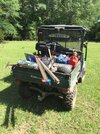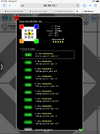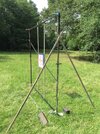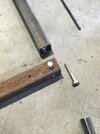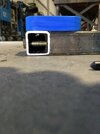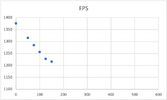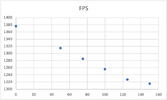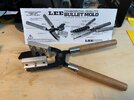JimGnitecki
Member
- Joined
- Mar 28, 2010
- Messages
- 1,258
Yesterday's range session was frustrating overall, as it failed to identify a handload that shoots well beyond 100 yards using the 485g Lee mold bullet that has a very narrow sharply pointed ogive. But I learned a LOT, AND I finally got the bullet to group at 150 meters = 163 yards, although the grouping is still completely unsatisfactory.
It was a very complicated session to manage, but in shooting 6 different loads of 5744 powder, 5 of them using my new Track of the Wolf expander setup, and after studying my 6 different Labradar logs, here sre some of the things I verified or learned:
- This bullet needs to be chambered so that it is in contact with the rifling. When in prior sessions I had some "jump", it would shoot great at 100 meters = 108 yards (as good as 0.62" 3-shot groups), but would not group at all at 150 meters. Based on forum info I had acquired from buffalo rifle websites, bullets with sharp narrow ogives rattle around too much and destabilize when allowed to jump. This is because a long narrow ogive necessitates a shorter bullet SHANK, and it is the shank that stablizes the bullet. If the bullets are in contact with the rifling BEFORE ignition occurs, they tend to fly better.
- The safest way to achieve a repeatable amount of rifling contact, despite slight variances in COAL and in case length, is to use an expander size and shape that secures the bullet enough to enable sensible no-shock handling and transport, but allows the bullet to "slide back" in the case once it has touched the rifling, and maintain JUST that light contact while the case is completing its chambering.
- The above expander's specific shape also eliminates the need to UNflare each cartridge after seating the bullet, thus eliminating one handloading operation.
- Having the bullet touch the rifling enable me to, for the first time ever with this bullet, get actual groups at 150 meters. The group size was still way too large (2 to 3 inches at 150 meters = 163 yards), but at least it was progress.
- The elimination of the jump apaprently also eliminated the funny transonic variance in bullet velocity versus distance from the muzzle that existed before, atfter 125 yards, which at my 3000 foot elevation, just happens to be the local speed of sound:
Before (i.e. with jump):
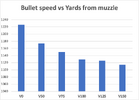
After (with no jump):
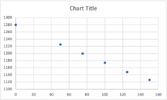
I assume this is furrther evidence of the improved bullet stability with the elimination of the jump.
By the way, the reason that the muzzle velcoties on the 2 graphs are different is because the first graph shows ALL the handloads in one graph while the 2nd graph shows one specific load. All the specific loads generate a graph like the 2nd graph, after I removed the jump.
- None of the handloads generated what I could honestly call "bad" average / SD / ES statistics, and some were pretty excellent (like SD = "2"). Basically, with the 5744 powder and this bullet, you really cannot generate bad SDs and ESs. 5744 really works well with the 45-70 caliber at loadings suitable for buffalo rifles. Notably, ALL buffalo rifle loadings for use with heavy, cast bullets, that you actually want to obturate to the barrel, WILL involve transonic velocities. You cannot load those heavy bullets to velocities low enough, or high enough, to aovid the transonic zone if you want to shoot long distances.
- The ballistic coefficient for this bullet changes dramatically with velocity. I used an online BC calculator that determines BC by comparing the bullet velocities at two different known ranges. That was an eye opener. At one extreme (the highest powder load and speed), the calculated BC was as low as 0.4. At the other extreme (the lowest powder load and speed) the calculated BC was just over 0.5! This might be why some BPCR shooters keep their muzzle velocities in the 1000 to 1100 fps region for use at some ranges.
- Loading these cartridges that enable the bullet to slide back into the case after hitting the rifling was NOT hard to do. Simple thumb pressure on the base of the cartriudge was sufficient to get the cartridge chambered sufficiently that the Sharps replica FALLING BLOCK was able to slide back up over the cartrudge base to seal the chamber. On a bolt action rifle this would have been even simpler and would have allowed for a tighter fit between case and bullet. Apparently, there are BPCR shooters who use "pusher tools" to do this, and some even load JUST the bullet first into the rifling, and then add the case with powder as a separate step. No kidding.
- In the handloads tried so far, I have found 3 muzzle velocity "nodes" located at 21.7g, 24.0g, and 25.5g of 5744. I now need to make way more cartridges at each of the 3 powder levels in order to ensure a large enough sample size to draw valid accuracy conclusions from.
I am still not sure if I can EVER get this bullet to shoot adequately at the longer ranges I want to shoot at (up to 600 yards available at our club facility). It certainly has not been easy so far.
Jim G
It was a very complicated session to manage, but in shooting 6 different loads of 5744 powder, 5 of them using my new Track of the Wolf expander setup, and after studying my 6 different Labradar logs, here sre some of the things I verified or learned:
- This bullet needs to be chambered so that it is in contact with the rifling. When in prior sessions I had some "jump", it would shoot great at 100 meters = 108 yards (as good as 0.62" 3-shot groups), but would not group at all at 150 meters. Based on forum info I had acquired from buffalo rifle websites, bullets with sharp narrow ogives rattle around too much and destabilize when allowed to jump. This is because a long narrow ogive necessitates a shorter bullet SHANK, and it is the shank that stablizes the bullet. If the bullets are in contact with the rifling BEFORE ignition occurs, they tend to fly better.
- The safest way to achieve a repeatable amount of rifling contact, despite slight variances in COAL and in case length, is to use an expander size and shape that secures the bullet enough to enable sensible no-shock handling and transport, but allows the bullet to "slide back" in the case once it has touched the rifling, and maintain JUST that light contact while the case is completing its chambering.
- The above expander's specific shape also eliminates the need to UNflare each cartridge after seating the bullet, thus eliminating one handloading operation.
- Having the bullet touch the rifling enable me to, for the first time ever with this bullet, get actual groups at 150 meters. The group size was still way too large (2 to 3 inches at 150 meters = 163 yards), but at least it was progress.
- The elimination of the jump apaprently also eliminated the funny transonic variance in bullet velocity versus distance from the muzzle that existed before, atfter 125 yards, which at my 3000 foot elevation, just happens to be the local speed of sound:
Before (i.e. with jump):

After (with no jump):

I assume this is furrther evidence of the improved bullet stability with the elimination of the jump.
By the way, the reason that the muzzle velcoties on the 2 graphs are different is because the first graph shows ALL the handloads in one graph while the 2nd graph shows one specific load. All the specific loads generate a graph like the 2nd graph, after I removed the jump.
- None of the handloads generated what I could honestly call "bad" average / SD / ES statistics, and some were pretty excellent (like SD = "2"). Basically, with the 5744 powder and this bullet, you really cannot generate bad SDs and ESs. 5744 really works well with the 45-70 caliber at loadings suitable for buffalo rifles. Notably, ALL buffalo rifle loadings for use with heavy, cast bullets, that you actually want to obturate to the barrel, WILL involve transonic velocities. You cannot load those heavy bullets to velocities low enough, or high enough, to aovid the transonic zone if you want to shoot long distances.
- The ballistic coefficient for this bullet changes dramatically with velocity. I used an online BC calculator that determines BC by comparing the bullet velocities at two different known ranges. That was an eye opener. At one extreme (the highest powder load and speed), the calculated BC was as low as 0.4. At the other extreme (the lowest powder load and speed) the calculated BC was just over 0.5! This might be why some BPCR shooters keep their muzzle velocities in the 1000 to 1100 fps region for use at some ranges.
- Loading these cartridges that enable the bullet to slide back into the case after hitting the rifling was NOT hard to do. Simple thumb pressure on the base of the cartriudge was sufficient to get the cartridge chambered sufficiently that the Sharps replica FALLING BLOCK was able to slide back up over the cartrudge base to seal the chamber. On a bolt action rifle this would have been even simpler and would have allowed for a tighter fit between case and bullet. Apparently, there are BPCR shooters who use "pusher tools" to do this, and some even load JUST the bullet first into the rifling, and then add the case with powder as a separate step. No kidding.
- In the handloads tried so far, I have found 3 muzzle velocity "nodes" located at 21.7g, 24.0g, and 25.5g of 5744. I now need to make way more cartridges at each of the 3 powder levels in order to ensure a large enough sample size to draw valid accuracy conclusions from.
I am still not sure if I can EVER get this bullet to shoot adequately at the longer ranges I want to shoot at (up to 600 yards available at our club facility). It certainly has not been easy so far.
Jim G
Last edited:


